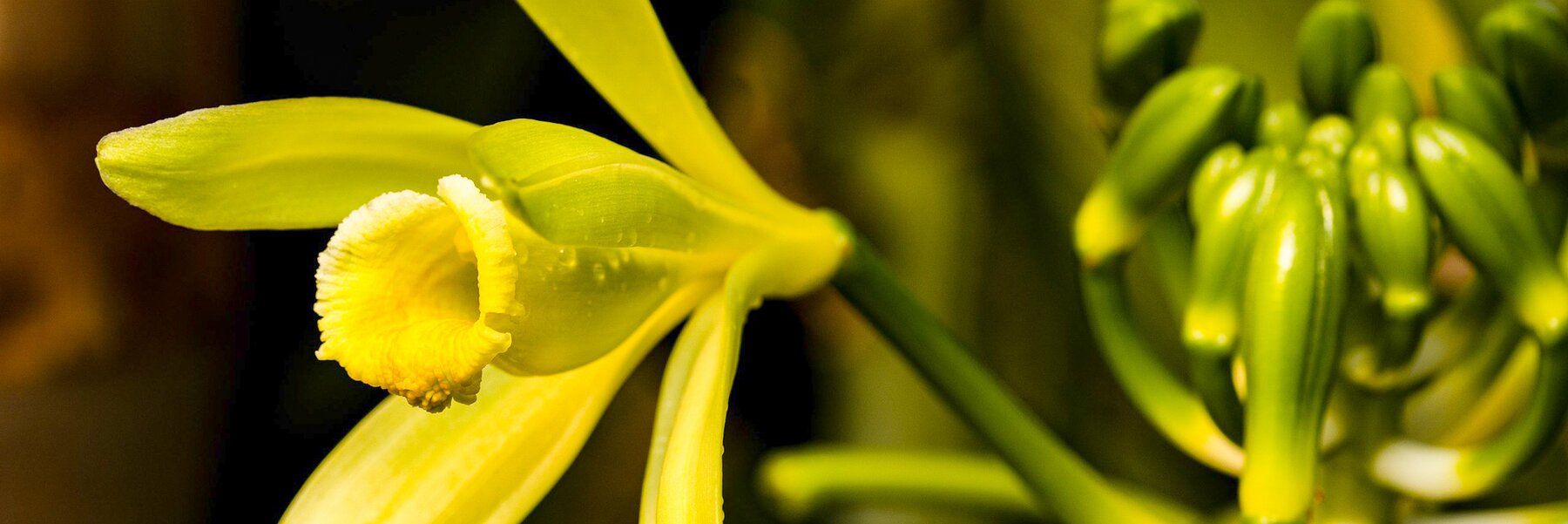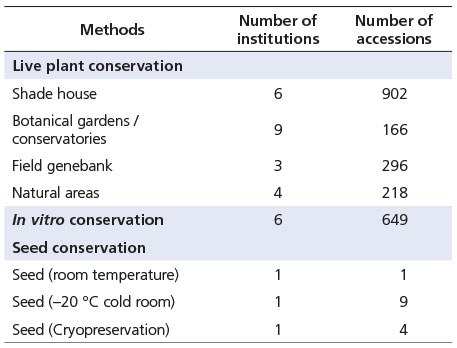Global Strategy for the Conservation and Use of Vanilla Genetic Resources
Global strategy for the conservation and use of Vanilla genetic resources was published in 2021 (Global Crop Diversity Trust 2021, DOI: 10.5281/zenodo.7544770). This document, developed with the input of a large number of experts, aims to provide a framework for the efficient conservation and effective use of globally important collections of Vanilla genetic resources. This webpage provides a summary of some of the its key findings and of the recommendations for priority actions.
Ex situ collections
The tables below give an overview of the ex situ collections of Vanilla species.
Gaps in collections and conservation status
Globally, there are 61 Vanilla species for which no accessions are conserved. All the species in section Membranacea are held in no or very few collections (five or fewer), as are more than three-quarters of the species in Xanata and Tethya. overall, most Vanilla species are not securely conserved in ex situ collections globally.
Management of collections
The charts belows shows the results of the survey regarding the frequncy of various management activities
Documentation
The survey asked respondents about the data they held on acces- sions. Just under 80% of the respondents reported having information on the taxonomy, if known (Figure below). More than half have photo or passport data on accessions, while one-third have phenotypic or genotypic information on the accessions. Very few of the respondents had a herbarium specimen or illustra- tion for the specific accession. Where various types of information was available, it was not available for all accessions.
Recommendations for priority actions
Priority Action 1: Hold a global workshop on the conservation of vanilla genetic resources, to inform stakeholders of the status of conservation and establish a platform for global collaboration.
It is necessary to build an effective platform for net- working and communications, so that conservers of vanilla genetic resources can collaborate and connect with key users and other stakeholders. An effective means of communication will enable those involved in ex situ conservation to:
-
share experiences.
-
collectively improve conservation practices.
-
establish quality management systems, protocols,
processes, and standards.
-
help build each other’s capacity.
-
address the need for safety duplication
-
adopt genebank information systems and share accession-level information.
Priority Action 2: Establish a global fund to support the long-term con-servation of unique vanilla diversity. Financial support for long-term conservation and use of vanilla genetic resources is not a priority for many donors, which means institutes have little in the way of annual or project funding to address vulnerabilities. If a global fund is established, with a competitive grants scheme, institutes would have the means to carry out priority actions. The fund could be set up to require complementary funds from national governments or individual institutions for a specific project, as well
as a commitment to increased annual budget allocations to secure the long-term conservation of this key global resource, which also has significant value for individual nations.
Priority Action 3: Establish a global initiative to secure the ex situ, in situ and circa situm conservation of unique vanilla diversity.
There is a need for a systematic survey and inventory of inter- and intra-species diversity of the vanilla in ex situ collections, farmers’ fields, and natural areas, from which a global map of the distribution of Vanilla species can be constructed. Also recommended is a global conservation planning exercise, to determine key priority sites to be targeted for detailed circa situm and in situ conservation interventions, including the creation of genetic reserves for vanilla genetic resources. The conservation interventions should include an early warning monitoring system for tracking the risk of loss of vanilla genetic diversity from farmers’ fields and natural areas.
Furthermore, ex situ collections require stronger
links and collaboration with circa situm, in situ and other protected sites, to secure the global diversity of cultivated and wild species in section Xanata and key representatives of section Tethya. This can be achieved by better linking global and national initiatives so that ex situ collection holders can offer their expertise and support to local farmers and those managing natural areas, mainly in Central and South America.
Increased engagement with farmers, farmer asso- ciations, community groups, NGOs and national extension services is also an important priority for the global system, given the limited research into crop improvement and the low number of providers of planting material in the private sector. Increased engagement will facilitate local access to these key genetic resources and ensure greater conservation through collection and safety duplication.
All these activities will require investment in developing and establishing a global initiative aimed at:
• securing vanilla diversity in farmers’ fields and in situ in the most important centers of diversity.
• collecting and conserving samples of this diversity in key ex situ collections.
• collaborating with national and local authorities to ensure their long-term commitment to conservation.
Partners and donor
The development of this crop conservation strategy was funded by the German Federal Ministry of Food and Agriculture (BMEL) as part of the three-year project led by the Crop Trust: Breathing New Life into the Global Crop Conservation Strategies: Providing an Evidence Base for the Global System of Ex Situ Conservation of Crop Diversity. The Crop Trust also cooperated with the Secretariat of The International Treaty on Plant Genetic Resources for Food and Agriculture (ITPGRFA) in the development of this document.













